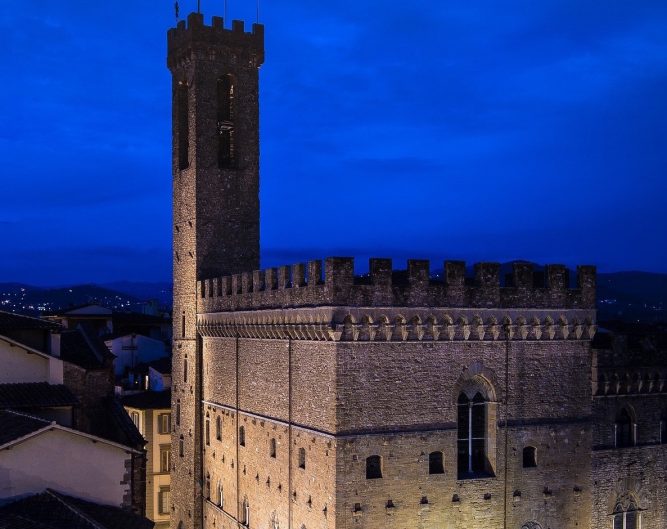Florence Museums Reopen after COVID-19 Restrictions

Thanks to the latest national decree, a number of state and city-run museums will once again welcome visitors–for the moment on weekdays only–starting on January 18. Uffizi director Eike Schmidt announced that while quickly opening the Uffizi complex “would be complicated,” the Boboli Gardens would be accessible starting Tuesday, January 19. Across the city, re-openings will be a gradual process, but a few will offer paid entrance immediately.
This group comprises:
— the Bargello National Museum of Sculpture and the Applied Arts; hours 8:45 am 1:30 pm. Inside the Chapel of the Podestà, hangs Giotto’s portrait of Dante Alighieri, thought to be the oldest portrait of him, wearing a red robe and holding the Divine Comedy in his hand. The artist, a contemporary of Dante’s, portrays the poet in the ranks of the Blessed and therefore in Paradise. The chapel was where prisoners condemned to death spent their last night in prayer and coincidentally where Dante’s exile was proclaimed in 1302.
— the Medici Chapels which includes the New Sacristy hosting Michelangelo’s famous tomb sculptures of Night and Day, Dawn and Dusk; hours 8:45 am – 1:30 pm on Monday and Tuesday, 2 – 6:30 pm Wednesday to Friday.
— the Palazzo Davanzati Museum of the Renaissance Home; open 2 – 6:30 pm.
— Palazzo Vecchio; open 9 am – 7 pm, Thursday 9 am – 2 pm. Inaugurated in the late 1200s, Palazzo Vecchio has been Florence’s symbol of civic power for more than seven centuries. Overlooking the Piazza della Signoria, “The Old Palace” has not only been the Town Hall of Florence since 1299, but also a museum of Roman archeological remains and Renaissance art works. In contrast to its stone exterior, the interior walls and ceilings of Palazzo Vecchio were later decorated by Vasari with intricate frescoes, elaborate oil paintings, and gilt paneled ceilings. Once inside, the resplendent golden interior and the sculptures scattered throughout the palace is breathtaking.
— Palazzo Vecchio’s Arnolfo tower walkway; open 9 am – 5 pm, closed Thursday.
— the Brancacci Chapel, which features Renaissance frescoes by Masaccio, Masolino and Filippo Lippi; open 10 am – 5 pm on Wednesday, Thursday and Friday. During the 1420s, Felice Brancacci wanted to decorate his family chapel in the church of Santa Maria del Carmine. The theme of the fresco cycle is the life of St. Peter, in addition to scenes from the story of Adam and Eve: The Temptation and the Expulsion from Paradise. Brancacci could not have known how important his decision would be to art history and humanism.
— the Brancacci Chapel and the Salvatore Romano Antiquities Foundation; open 10 am – 5 pm on Monday.
— the Novecento Museum of 20th and 21st Century Art; open 11 am – 7 pm, Thursday 11 am – 2 pm. The Novecento Museum of 20th and 21st Century Art, or the Museo del Novecento, houses more than 4,000 exhibits displaying the development of modern Italian art movements. Located in Piazza Santa Maria Novella, the Museo del Novecento was established on December 6, 2010 with the aim of promoting modern and contemporary art. Thanks to the generosity and passion for art of contributing artists, philanthropists, and private collectors, the art works in the Permanent Collection has been expanding since the museum’s inception. Since the permanent collection is arranged in chronological order, visiting the museum would be like traveling back to the beginning of the 20th century and walking along a timeline of arts.
— the Bardini Museum; open 11 am – 5 pm. The Bardini museum is itself a work of art. With its distinctive blue painted rooms, it was once the home of the famous antique dealer Stefano Bardini, who donated his residence, gallery, and garden to the city of Florence after his death in 1922. The collection contains a lovely 14th century “Charity” by Tino da Camaino, and two works by Donatello, including an innovative painted and golden Madonna and Child relief. A pair of Florentine Renaissance artworks stands out: Pollaiolo’s St. Michael slaying the dragon and Piero di Cosimo’s St. Jerome. (rosanna cirigliano)
